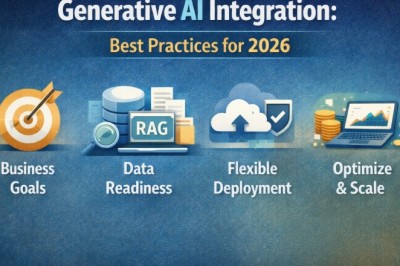views
In the age of digital transformation, cybersecurity has become a key aspect of protecting individuals and organizations against cyber-attacks. With each passing year, new cybersecurity challenges emerge, and security professionals must be up-to-date with the latest best practices to keep their systems secure. As we enter the year 2023, the need for robust cybersecurity practices has never been more important.
In this blog, we will discuss the best cybersecurity practices that individuals and organizations can implement to protect their digital assets. Watch our Cyber Security Course video to have a better understanding of the particular topic.
Here are the following topics we are going to discuss:
- What is Cybersecurity?
- Why do we need Cybersecurity?
- Top Best Cybersecurity Practices for 2023
- Conclusion
What is Cybersecurity?
Cybersecurity is the activity of defending systems, networks, and programs from cyberattacks. These cyberattacks frequently aim to access, modify, or delete sensitive data, extort money from users, or interfere with normal business operations.
A range of security measures must be put in place to safeguard networks, computers, applications, and data from unwanted access and harmful assaults.
Cybersecurity is becoming a bigger problem for businesses of all sizes and across all sectors. Organizations must continually watch for harmful behaviour as new risks arise every day.
Organizations must put in place a range of defences against these attacks, including firewalls, antivirus software, intrusion detection systems, and encryption. Patching and security upgrades are essential to guard against known vulnerabilities.
In order to safeguard their systems and data, organizations need also create and implement rules and procedures. Access control, data storage, password protection, incident response, and user education should all be covered by these rules. Furthermore helpful is security awareness training, which makes sure users are aware of the dangers and how to avoid them.
Finally, organizations should develop a cybersecurity plan to ensure that all security measures are implemented properly and that any potential risks are identified and addressed. This plan should include a risk assessment, a response plan, and a monitoring plan. A well-developed cybersecurity plan can help organizations reduce the risk of cyberattacks and protect their data and systems.
Why do we need Cybersecurity?
Protecting data and systems from unwanted assaults requires both organizations and people to practice cybersecurity. The right security precautions can stop a range of attacks. Therefore, it's critical to comprehend why cybersecurity is so crucial.
Safeguarding people and businesses from unwanted assaults is the primary reason why cybersecurity is essential. Criminals that operate online are always seeking new methods to steal data, stop businesses, and even cause harm. Organizations and people may lessen the danger of these risks by having a strong security system in place and staying secure.
The need for cybersecurity is also emphasized by the need to safeguard an organization's reputation. A security breach that compromises an organization's data may have a significant negative impact on that company's reputation. Consumers could stop believing in them, and other businesses would stop wanting to work with them.
Last but not least, cybersecurity is essential to safeguarding an organization's financial data. Cybercriminals can access funds using stolen data, which can result in the theft of money. Organizations may safeguard their data and preserve their financial information by putting the proper security measures in place.
Top Best Cybersecurity Practices for 2023
Businesses must keep ahead of the curve by employing the best cybersecurity strategies for 2023 due to the always-changing cyber threat scenario. Cybersecurity now includes involves safeguarding the users of systems, networks, and data in addition to those things.
Businesses must make sure that all of their systems and procedures are up to date with the most recent security technologies and techniques in order to stay ahead of the most recent dangers.
Let’s see each cybersecurity practice one by one to have a better understanding of the evolving technology:
- Use Antivirus and Anti-Malware Software
The best defence against harmful software, such as Trojans, worms, and viruses, is antivirus and anti-malware software. On all of your devices, install antivirus and anti-malware software, and keep them updated with the most recent virus definitions. Antivirus and anti-malware software solutions abound, both free and commercial, and include Avast, Norton, and Kaspersky.
- Use Virtual Private Networks (VPNs)
You may connect to the internet through a server that is situated in another country using a VPN, which is a safe and secure connection. By using a VPN, you can shield your data from hackers and other bad actors while maintaining your privacy online. A VPN can be used to get around internet restrictions or access geo-restricted material.
- Implement a Firewall
A firewall is a security tool that keeps track of and regulates both inbound and outbound network traffic. By restricting traffic from known malicious IP addresses and ports, firewalls can stop unwanted access to your network. Make sure your operating system's firewall is turned on, and think about adding a special firewall device for your network.
- Educate Employees on Cybersecurity Best Practices
Workers are frequently the cybersecurity chain's weakest link in a business. Unintentionally, they could open phishing emails, click on harmful websites, or download malware-filled files.
Giving staff cybersecurity training is a good approach to making them more aware of the dangers of online attacks and educating them on how to spot and handle them.
- Regularly Back Up Your Data
In the event of a cyberattack or a data breach, data backups are crucial. By regularly backing up your data, you may be confident that in the case of a calamity, you can easily retrieve your data. To save your data safely in the cloud, you may utilize cloud-based backup services like Google Drive, Dropbox, or iCloud.
- Conduct Regular Security Audits
Your systems and procedures may have vulnerabilities that can be found with regular security audits. Reviewing your security policies, systems, and processes to make sure they adhere to industry best practices is part of conducting a security audit.
Watch Intellipaat's YouTube video on Cyber Security Training for complete guidance on understanding this well-known field of technology.
Conclusion
We wish you luck in learning valuable information about your company's top cybersecurity procedures from this blog. We attempted to convey the value of cybersecurity in the context of the modern world in this blog. The defence of systems against diverse attacks is significantly aided by cyber security. Therefore, we would use the top cybersecurity best practices for 2023 that are described above, which directly assist the organization in better security from various malware. These practices help the organization to avoid the various threats and malware that actually impact the growth of the organization.























Comments
0 comment